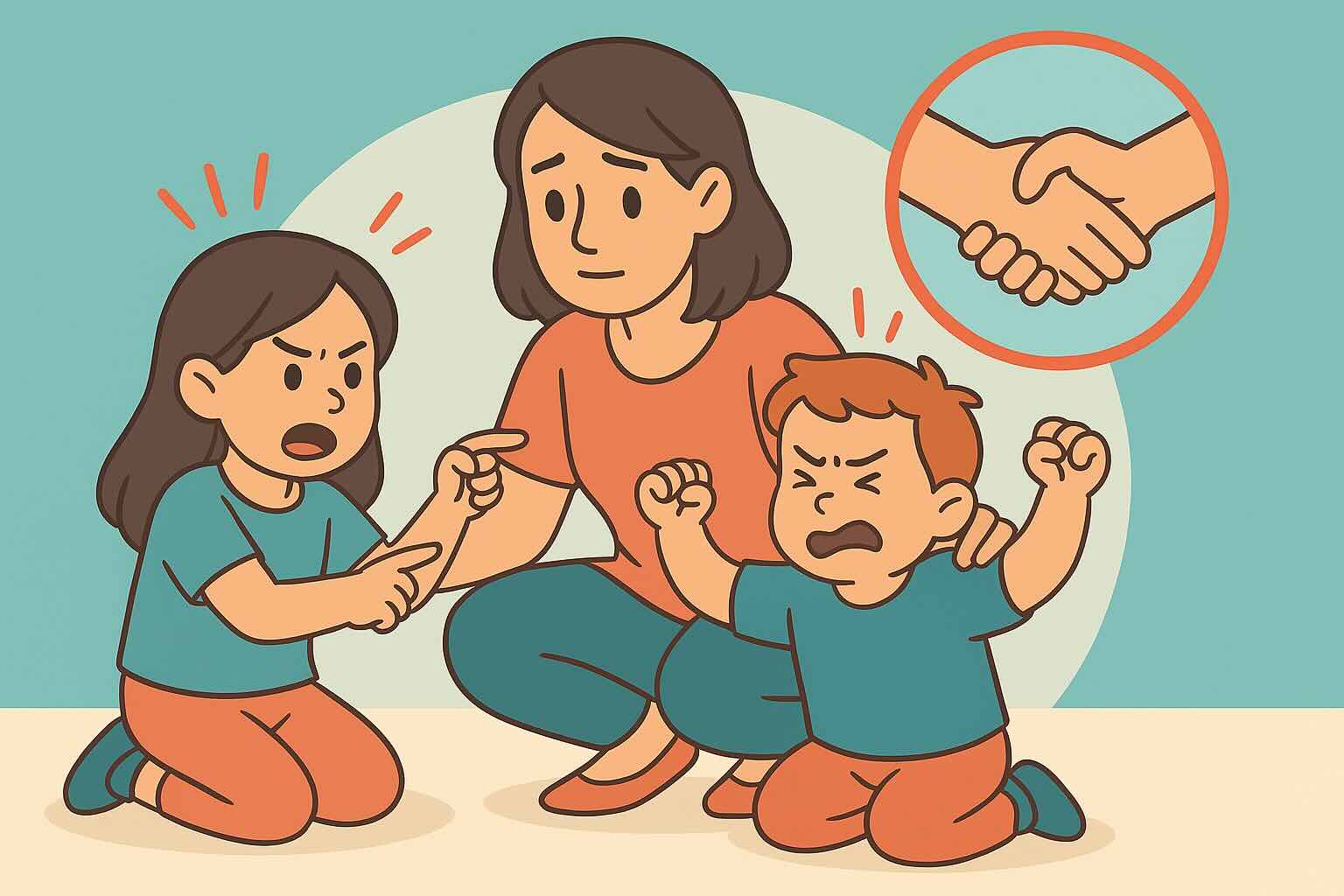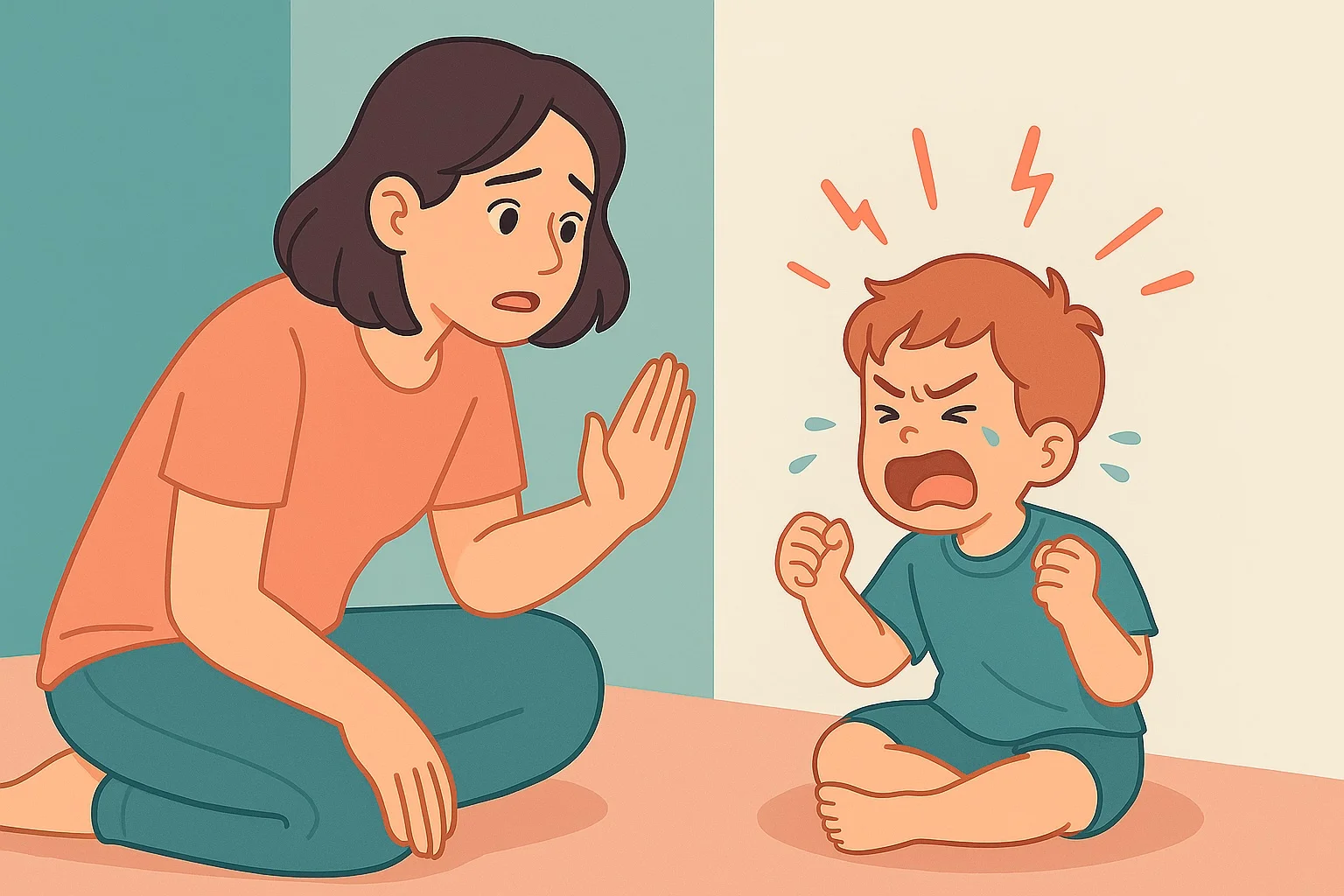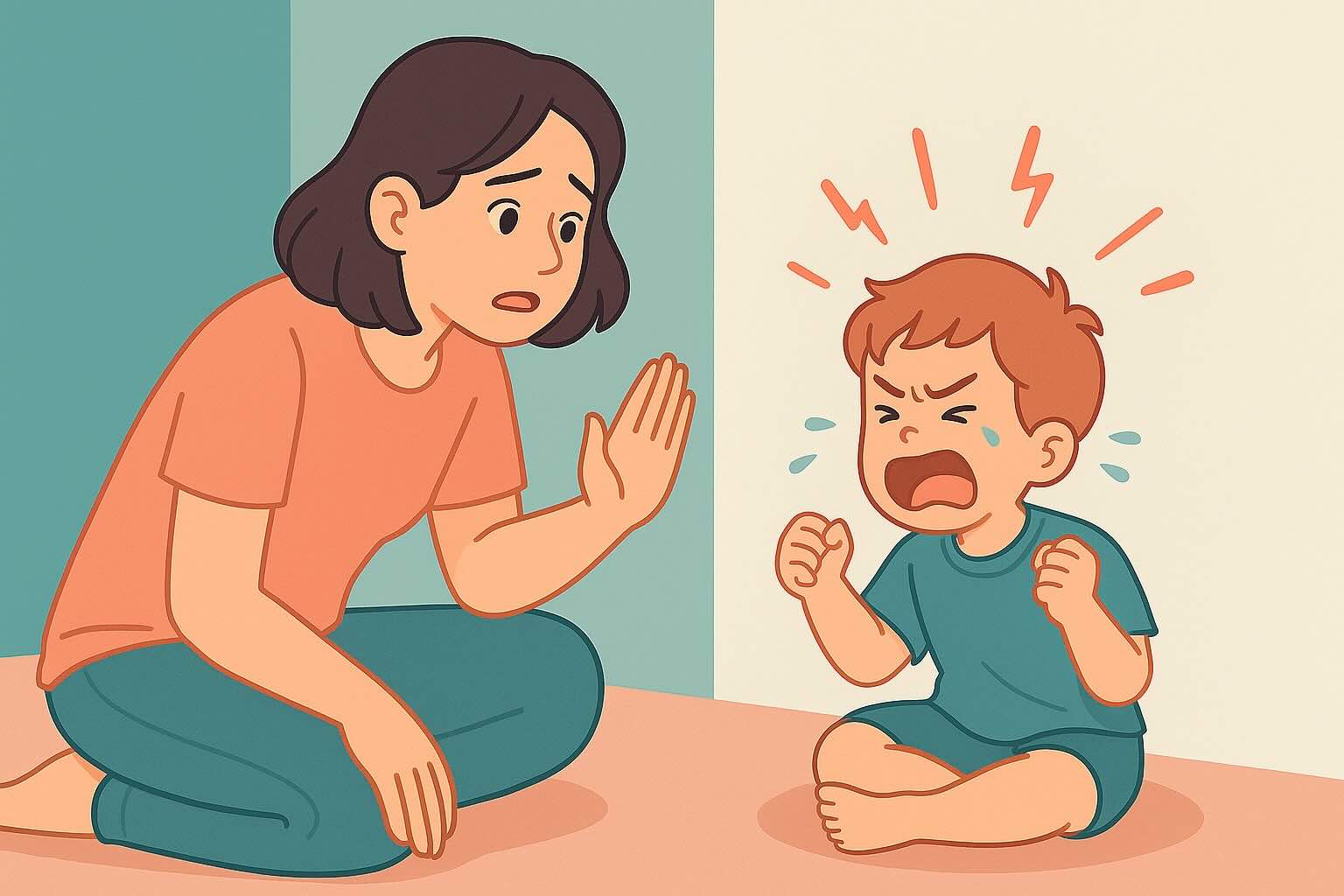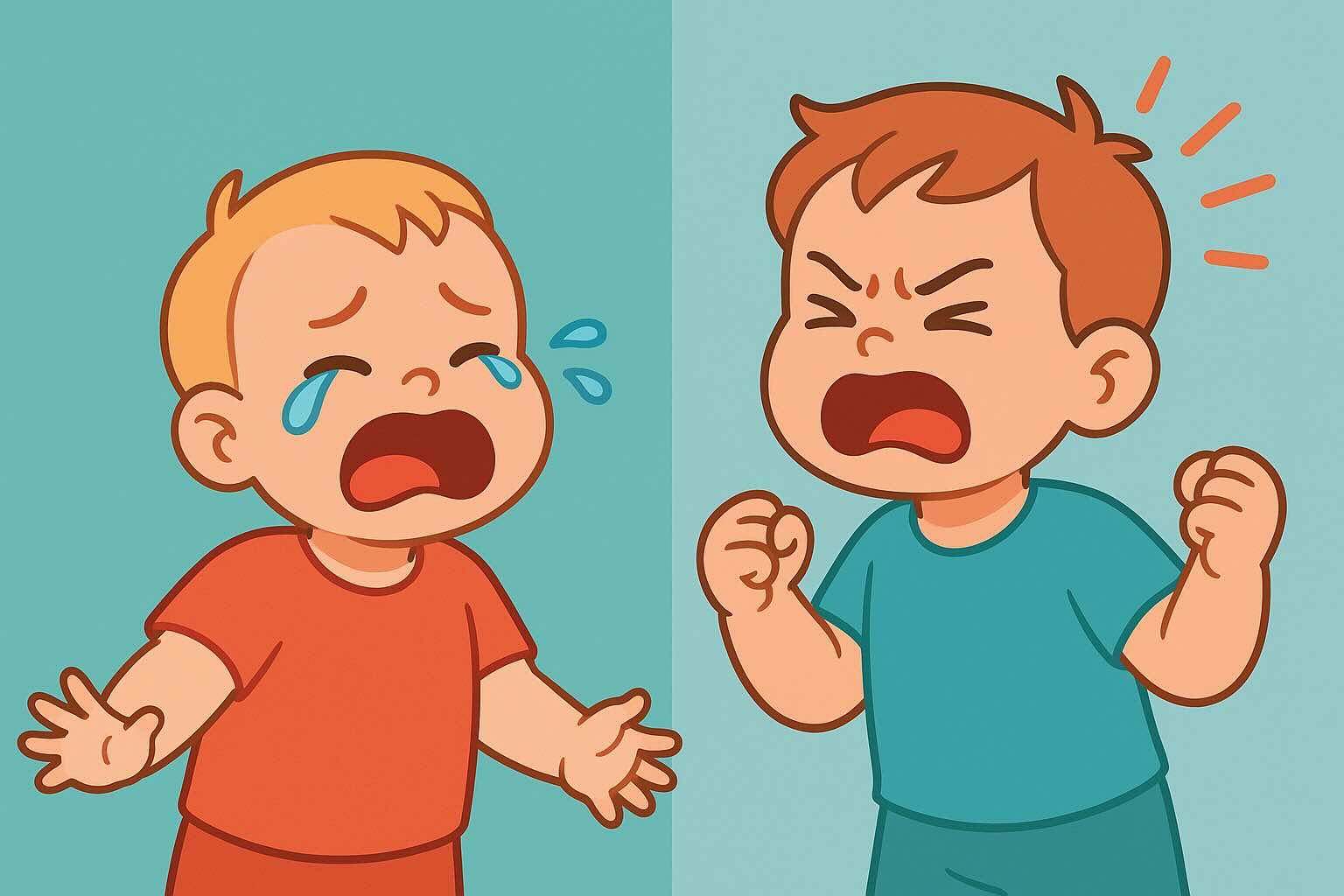Managing Sibling Outbursts: 8 Effective Strategies


Managing Sibling Outbursts and Conflicts: When Brothers and Sisters Trigger Big Emotions
Transform sibling conflicts from chaos into opportunities for emotional learning and family growth
It's 3 PM on a Tuesday. Your 5-year-old is building an elaborate tower with blocks when their 3-year-old sibling accidentally knocks it over. Within seconds, you have one child screaming about their "masterpiece" being destroyed and another child crying because they're being yelled at. Both children are now escalating each other's emotions, and you're wondering how a simple afternoon turned into emotional chaos.
Sound familiar?
Sibling-triggered outbursts are among the most challenging parenting situations because you're managing multiple emotional storms simultaneously while trying to maintain fairness, safety, and family harmony.
The good news: These conflicts are also incredible opportunities to teach emotional regulation, empathy, and conflict resolution skills that will benefit your children for life.
This comprehensive guide provides you with practical strategies to transform sibling chaos into learning opportunities while maintaining your sanity and family peace. For foundational understanding of tantrums and outbursts, see our toddler tantrums guide and preschool outbursts guide.
What You'll Learn in This Guide
- Why Sibling Conflicts Trigger Intense Outbursts - The psychology behind sibling emotional contagion
- The "Emotion First, Solutions Second" Approach - How to handle multiple upset children simultaneously
- Age-Gap Considerations - Different strategies for close vs. wide age differences
- Common Sibling Triggers and Prevention - Reducing conflicts before they escalate
- Fairness vs. Individual Needs - Teaching equity without identical treatment
- Including Both Children in Solutions - Building cooperation and empathy
- When Sibling Patterns Need Professional Help - Red flags and resources
Estimated reading time: 10 minutes
Understanding Sibling-Triggered Outbursts: The Emotional Domino Effect
Why Siblings Push Each Other's Emotional Buttons
Proximity and Competition: Children who live together know exactly which behaviors will get the biggest reaction from their siblings.
Emotional Contagion: Children naturally mirror and amplify each other's emotional states. One child's distress often triggers anxiety, frustration, or excitement in their sibling.
Limited Resources and Attention: From a child's perspective, parental attention, toys, and space feel finite. This creates natural competition and protective responses.
Developmental Differences: Different ages have different emotional regulation abilities, creating mismatched expectations and frustrations.
The Unique Challenge of Multiple Emotional Storms
Unlike single-child outbursts where you can focus entirely on one child's emotional needs, sibling conflicts require you to:
- Manage multiple emotional states simultaneously
- Remain fair while addressing different developmental needs
- Prevent emotional escalation between children
- Teach conflict resolution in real-time
- Maintain safety for all family members
Common Sibling Outburst Triggers
Resource Conflicts: Toys, games, parental attention, physical space Attention Competition: One child acting out when sibling receives focus Developmental Mismatches: Older child frustrated by younger sibling's abilities Justice and Fairness: Perceived unequal treatment or consequences Physical Boundary Violations: Touching, taking, or entering personal space without permission
The "Emotion First, Solutions Second" Framework
This approach recognizes that children cannot engage in problem-solving until their emotional intensity decreases.
Step 1: Your Emotional Regulation (The Foundation)
Before addressing any child, take a moment to regulate yourself:
Internal self-talk:
- "I don't need to solve this immediately"
- "Both children are learning and growing"
- "I can handle this situation calmly"
- "This is not a crisis—it's a learning opportunity"
Avoid common emotional traps:
- Frustration about interrupted plans or activities
- Pressure to immediately restore peace
- Taking sides based on who seems more "right"
- Feeling responsible for preventing all conflicts
Step 2: Address Immediate Safety and Emotional Validation
If there's physical aggression or safety concerns, address those first: "I see hitting. No hitting in our family. I need to keep everyone safe."
For emotional outbursts without safety issues, start with validation: "I see two children with big feelings. Sarah, you're upset about your tower. Jake, you're sad that your sister is angry at you."
Step 3: Set Boundaries for Both Children
Address problematic behaviors from both children:
- "Sarah, you cannot yell at your brother when you're upset."
- "Jake, you cannot grab things from your sister."
- "Both of you, no hurting each other with words or hands."
Step 4: Guide Individual Emotional Regulation
Help each child process their specific emotions:
For the "victim": "Your tower took a long time to build. You're disappointed it got knocked down. That's a hard feeling."
For the "perpetrator": "You feel bad that your sister is upset with you. You didn't mean to knock it down."
Step 5: Facilitate Problem-Solving Together (When Calm)
Only after emotions have decreased, guide collaborative solutions: "Now that everyone is calmer, let's figure out what to do. What could help Sarah feel better? What could help Jake be more careful around towers?"
Age-Gap Specific Strategies
Close Age Gaps (1-2 Years Apart)
Challenges:
- Similar developmental needs but different personalities
- Intense competition for resources and attention
- Both children often at similar emotional regulation levels
Strategies:
- Avoid comparisons: "Why can't you share like your brother?"
- Acknowledge individual needs: "You both want the same toy right now. That's frustrating for both of you."
- Create individual spaces: Separate areas where each child can play without interference
- Schedule one-on-one time: Prevent attention competition through individual connection
Moderate Age Gaps (3-4 Years Apart)
Challenges:
- Older child has higher expectations but still developing regulation
- Younger child wants to do everything older sibling does
- Different interest levels and abilities create natural friction
Strategies:
- Acknowledge developmental reality: "Your sister is still learning what you already know about being gentle."
- Give older child special responsibilities: "You can help teach your brother how to build carefully."
- Validate older child's frustration: "It's hard when someone messes up your projects. You want to play without interruptions sometimes."
Wide Age Gaps (5+ Years Apart)
Challenges:
- Older child may feel responsible for managing younger sibling
- Younger child idolizes older sibling but can't match abilities
- Parents may have unrealistic expectations of older child's maturity
Strategies:
- Don't make older child the "helper parent": They're still a child learning emotional regulation
- Validate older child's need for age-appropriate activities: "You want to do big kid things without your little brother sometimes. That makes sense."
- Teach younger child to respect boundaries: "Your sister is working on a project. You can play with your own toys while she finishes."
Prevention Strategies: Reducing Sibling Conflict Triggers
Environmental Setup for Success
Physical Space Management:
- Create individual "special toy" areas that siblings cannot access
- Provide duplicate items for frequently fought-over objects
- Designate quiet spaces where children can retreat when overwhelmed
- Establish clear boundaries for personal belongings
Attention Distribution:
- Schedule individual time with each child daily
- Acknowledge positive interactions between siblings
- Avoid inadvertently giving more attention to the "problem child"
- Create family activities that naturally involve cooperation
Proactive Conflict Prevention Conversations
Before challenging situations:
Sharing scenarios: "We're going to play with the blocks together. What can you do if your brother wants to use the blocks you're using?"
Attention-sharing situations: "I need to help your sister with homework. What can you do while you wait for my attention?"
Transition times: "In 5 minutes, we're cleaning up toys. How can you help each other make cleanup easier?"
For more prevention strategies that work for all situations, see our tantrum prevention strategies guide.
Teaching Conflict Resolution Skills During Calm Moments
Practice taking turns: Use timers, talking sticks, or other concrete tools Role-play common scenarios: Act out toy conflicts and practice solutions Read books about sibling relationships: Normalize conflicts and model solutions Celebrate cooperative moments: "I noticed you shared your snack with your brother. That was kind."
Handling Specific Sibling Outburst Scenarios
Scenario 1: The Toy Grab and Screaming Match
What happened: 3-year-old takes toy from 5-year-old. 5-year-old grabs it back and starts yelling. 3-year-old begins crying and trying to hit.
Your response:
-
Address safety first: "I see grabbing and hitting. No grabbing toys. No hitting people."
-
Validate both emotions: "Emma, you were playing with that toy and Tommy took it. That's frustrating. Tommy, you wanted the toy your sister had. That feeling is normal."
-
Set boundaries: "Emma, you cannot yell at your brother. Tommy, you cannot take toys from people."
-
Guide problem-solving: "Who was playing with it first? Tommy, what can you do when you want something your sister has? Emma, how can you tell your brother you're still using something?"
-
Practice solutions: "Let's try this again. Tommy, can you ask Emma for a turn? Emma, can you tell Tommy when you'll be finished?"
Scenario 2: The Attention Competition Outburst
What happened: While helping one child with homework, the other child begins acting out, demanding attention, and escalating to an outburst.
Your response:
-
Acknowledge both needs: "Sarah needs help with homework right now. Jake, you want my attention too."
-
Set expectations: "I will spend time with Jake after Sarah's homework is finished. Jake, you cannot interrupt by yelling or being disruptive."
-
Give specific alternatives: "Jake, you can draw quietly at the table with us, play with your blocks, or look at books. When homework is done, you'll have my full attention."
-
Follow through: Actually give the waiting child focused attention after the first child's needs are met.
Scenario 3: The Fairness and Justice Meltdown
What happened: One child receives something the other doesn't (different bedtime, different privilege, different consequence) and the "left out" child has an outburst about unfairness.
Your response:
-
Validate the feeling: "You think this isn't fair. You want everything to be the same for both of you."
-
Explain family equity: "Fair doesn't always mean identical. We give each person what they need. Different ages need different things."
-
Give examples: "Your brother gets to stay up later because he's older. You get to nurse/have a pacifier because you're younger. Everyone gets what they need."
-
Avoid negotiating during the outburst: Don't change your decision just to stop the outburst.
Understanding age differences is crucial - see our comparison of 18-month vs 2-year behaviors for insight into developmental differences.
Scenario 4: The Chain Reaction Emotional Contagion
What happened: One child's outburst triggers anxiety, frustration, or acting out in their sibling, creating multiple simultaneous emotional storms.
Your response:
-
Stay calm and grounded: Your emotional regulation becomes even more critical with multiple upset children.
-
Address the emotional contagion: "I see that when your sister is upset, it makes you feel upset too. Big feelings can be catching sometimes."
-
Separate if needed: "I'm going to help each of you calm down. Sarah, you can use your calm-down corner. Jake, you can take deep breaths with me."
-
Process together when calm: "Earlier, when Sarah was upset, Jake got upset too. Let's talk about what that was like for everyone."
If these situations happen in public spaces, see our public outburst survival guide for additional strategies.
Teaching Fairness vs. Individual Needs
Moving Beyond "Identical Treatment"
Children's fairness obsession is developmentally normal but needs guidance toward understanding equity.
Instead of: "Life isn't fair, deal with it." Try: "Fair means everyone gets what they need, not that everyone gets the same thing."
Examples of Fair but Not Identical Treatment
Bedtime differences: "Your sister stays up later because she's older. When you're her age, you'll get to stay up later too."
Privilege differences: "Your brother gets to use scissors because he knows how to be safe. You'll learn that skill too."
Consequence differences: "Different choices lead to different consequences. Your sister made a different choice than you did."
Attention differences: "Sometimes one person needs more help. Sometimes you need more help, sometimes your brother does."
Teaching Empathy Through Individual Needs Recognition
Help children understand their siblings' perspectives:
- "Your sister is having a hard day. What do you think would help her feel better?"
- "Your brother is still learning how to control his body. Remember when you were learning that?"
- "Everyone in our family gets what they need. Sometimes that looks different for different people."
Including Both Children in Solutions
Collaborative Problem-Solving Approach
After emotions have calmed, involve both children in finding solutions:
Step 1: Describe what happened without blame: "Earlier, both of you wanted to use the tablet. That led to arguing and grabbing."
Step 2: Ask for input from both children: "What ideas do you have for next time when you both want the same thing?"
Step 3: Guide toward workable solutions: "Taking turns sounds like a good idea. How could we make that work?"
Step 4: Make a plan together: "So we'll use the timer. When it goes off, you switch. If someone doesn't want to switch, what should happen?"
Building Sibling Cooperation
Celebrate moments of natural cooperation: "I noticed you helped your sister reach that toy. That was thoughtful."
Create opportunities for teamwork: "You two are great at building together. What could you create as a team today?"
Acknowledge both children's growth: "You're both getting better at working out problems together. That's what families do."
The Family Reflection Process
Processing Sibling Conflicts as a Family Unit
During calm family time (dinner, bedtime routine, etc.), process difficult moments:
Include all family members in the conversation: "Earlier today, we had some big feelings when you two were fighting about the blocks. Let's talk about what happened and what we learned."
Give each child a voice: "Sarah, how did you feel when your tower got knocked down?" "Jake, how did you feel when Sarah yelled at you?"
Focus on family values and solutions: "In our family, we help each other with big feelings. What are ways we can do that better?"
Teaching Siblings to Support Each Other
Model empathy and support: "I see your brother is having a hard time. What's one way you could help him feel better?"
Avoid forcing artificial kindness: Don't require apologies or hugs if children aren't genuinely feeling sorry or affectionate.
Acknowledge the impact of outbursts on the whole family: "When one person has big feelings, it affects everyone. We all work together to help each other."
For specific communication scripts that work during emotional moments, check our tantrum communication scripts guide.
When to Seek Professional Help
Concerning Patterns in Sibling Relationships
Seek professional support if:
Safety concerns:
- One child consistently hurts or threatens to hurt their sibling
- Aggressive behavior that escalates despite intervention
- One child seems genuinely afraid of their sibling
Emotional patterns:
- One child consistently triggers outbursts in their sibling deliberately
- Extreme emotional reactions that don't improve with intervention
- Family functioning significantly impacted for several months
Developmental concerns:
- Wide gap between age-expected behavior and actual behavior
- Regression in previously mastered emotional or social skills
- Persistent difficulties in multiple environments (home, school, social settings)
Types of Professional Support
Family therapists: Help with overall family dynamics and communication patterns Child psychologists: Address individual emotional regulation and behavioral concerns Parenting coaches: Provide specific strategies for managing challenging family dynamics Pediatricians: Rule out medical or developmental factors contributing to behavior
Success Stories: Real Families Finding Harmony
The Rodriguez Family: From Daily Battles to Collaborative Problem-Solving
*"Our 4-year-old and 6-year-old were fighting constantly. Every interaction seemed to end in screaming. Learning to validate both children's emotions while setting clear boundaries changed everything. Now when conflicts start, I say 'I see
Multi-Child Support
Manage profiles for multiple children with personalized conversations and age-appropriate advice for each child.

Struggling with tantrums?
Get personalized coaching support available 24/7. Your parenting coach understands what you're going through.
Try RootWise Free →Free Tantrum Scripts
Help your toddler manage big emotions with these strategies and scripts.
Frequently Asked Questions
Need personalized support?
RootWise's AI coach can provide tailored strategies for your specific situation, available 24/7 when you need it most.
Learn More About AI Coaching →



